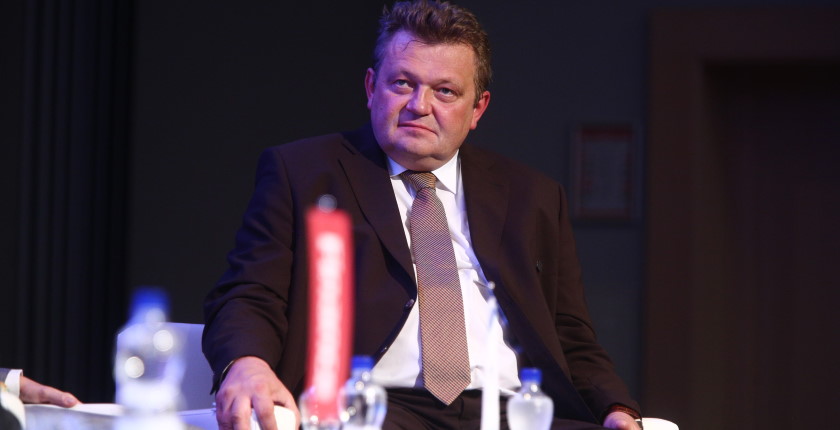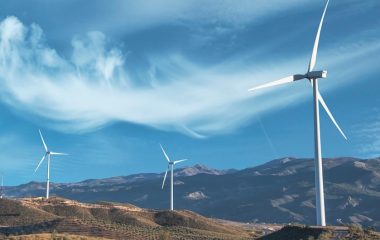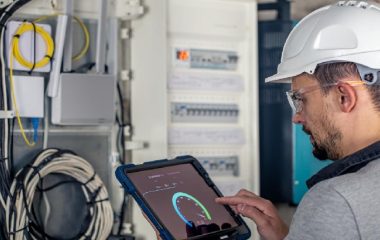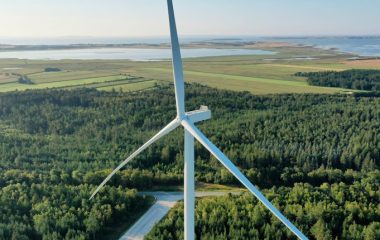
Photo: ELES
Share
ELES is building its position through development projects, with a strong international component. The Slovenian electricity transmission system operator or TSO obtained more than EUR 100 million from the European Union and Japan for the purpose, Chief Executive Officer Aleksander Mervar revealed in an interview with Balkan Green Energy News. He said the company’s responsibility is to help a socially effective transition to a carbon-free future.
The penetration of energy from renewable sources is accelerating throughout the world. What is ELES doing to keep up? What is its task regarding the challenges that arise?
When looking at the integration of renewable sources into the energy system, ELES operates in three key directions, which are then divided into several smaller ones. The first is to increase the transmission capacity of the existing electricity grid, which will allow for a further increase in electricity transmission over long distances.
The second is the support to dispersed and micro electrification, which, together with active demand response, is becoming an increasingly important factor in the stability of electricity networks. The third major direction is the sector coupling – interconnecting electricity with other clean energy sources and energy networks, as well as transport.
Our job is to, through operational, investment, and development activities, projects, and co-creation of legislation expand our knowledge and enable a socially effective transition to a carbon-free future.
How does ELES, a state-owned firm, navigate between its corporate interests, the pace of upgrades and the government’s demands?
In our line of work, we must seek a balance between the expectations and interests of many stakeholders. The challenge is to reach compromises, but the most important thing is to make the business transparent. We put a lot of effort into maintaining partnership relations with key stakeholders.
I came to the company 12 years ago and I have been the CEO since 2013. All this time we have been lucky to have an efficient supervisory board. And last but not least, it is crucial to appreciate your own people.
You know, nothing has committed us to implement development projects that require a lot of resources. But with good results from our strategic innovation activities, we gained more trust from key decision-makers and other stakeholders. We have always delivered everything that was needed at the right moment.
Our activities in the field of innovation were also recognized by the European Commission, from which we received significant financial support. So far, we have obtained more than EUR 100 million in funding for our development projects from the European Union and Japan.
How will the interconnection projects with Italy and Hungary affect the domestic grid and electricity system?
New interconnection projects are preparing us for large fluctuations in the geographical concentration of renewable energy production and the expected increasing changes in the direction of flows between the largest energy centres in Europe. Within these fluctuations, Slovenia will be increasingly exposed to market pressure and operational reliability.
Increasing transmission line capacity with interconnections is the answer to all these challenges. In addition, the home network will be even better utilized than before and we will also create a positive effect on the cost of the transmission network for customers. However, it should also be emphasized at this point that interconnections are not the only answer to these challenges.
At ELES, we also pay close attention to the controllability of the network, which is our main asset today when compared to neighbouring countries and the electricity industry in Europe. Along with our national and international projects, Slovenia has transformed from a critical point into one of the most flexible electricity hubs in Europe.
Will the Sincro.Grid project that you are implementing with Croatia benefit households and electricity consumers?
Yes, smart grid project Sincro.Grid will positively affect Slovenian and Croatian grids and the grids of neighbouring countries. It will generate financial and social benefits, as well as environmental benefits by reducing CO2 emissions. It will enable the controlled transmission of large quantities of renewable energy from Southeastern Europe to western markets.
With the Sincro.Grid project we will be solving problems with overvoltage, which are tied to the ageing of equipment and greater defect probability and a lower level of reliability, with the implementation of compensation devices in both Slovenian and Croatian transmission grids.
The Virtual Cross-Border Control Centre is completely new idea on a global scale
By implementing the battery storage (10 MW, 50 MWh), we will enable the penetration of this technology into the most demanding areas of system operation associated with frequency fluctuation. With the DTR system for determining operating limits, we will further increase cross-border energy transmission capacities on existing transmission lines.
A completely new idea on a global scale is the Virtual Cross-Border Control Centre (VCBCC). With VCBCC we will obtain additional functions in the existing ELES and HOPS control system, such as voltage control and loss optimization, monitoring and effective renewables management and support for remote operation of new devices – SVC / STATCOM, VSRs (variable shunt reactors), mechanically switched capacitor (MSC), battery storage.
ELES won the ISGAN Award of Excellence for the Smart Grids and Smart Communities Demonstration Project (NEDO) and the FutureFlow research project. How does it reflect on your plans?
The first and the second-place awards for the NEDO and FutureFlow projects on a global scale are great recognition for ELES, and at the same time, a strong proof to ourselves and others that even traditionally conservative TSOs can be the bearers of the most advanced development and innovation activities – and very successful.
At ELES, we operate thoughtfully and systematically and part of such an approach are two documents that have recently been approved by the supervisory board. These are the ELES Sustainability Strategy until 2050 and the ELES Long-Term Strategic Plan 2021-2025.
Just as the ELES strategic documents have been the common thread of our work for about 10 years, we can say that these documents represent the framework of our future work. The positive opinion of the participants in the projects and the external public give us the inspiration to carry out the projects we have set for ourselves with excellence in the future as well.

Can you compare the emerging battery technology with conventional power storage in terms of costs and operability? What is the role of batteries and capacitors in your sector?
Conventional storage of electricity is represented by pumped storage hydropower plants (PSHPs). Their basic function is to store larger amounts of energy, so they are built in such a way that they operate in full cycles, where the entire accumulation of the upper basin is used.
The size of the accumulation affects the length of the cycle, which can last for several days or even weeks. The power plant pumps when prices are low and produces during high electricity prices and thus generates a profit.
Contemporary battery electricity storage systems (BESS) are not suitable for such operation, since they are significantly more energy limited than PSHPs. With BESS we mainly use their speed and higher efficiency, so they are very suitable for performing fast frequency control or even for increasing the inertia of the system.
Battery storage is more cost-effective than pumped storage hydropower plants for fast frequency control or even for increasing the inertia of the system
For these purposes, an investment in the BESS is also more economically justified than an investment in the PSHP. Also, the siting of a BESS is significantly easier than with conventional sources. A great advantage of the BESS is also the ability to perform multiple functions simultaneously, which is welcomed especially in cases where such systems are included at the level of end users.
Capacitors are used in the field of electricity transmission mainly to improve voltage conditions, i.e. in the field of reactive power and not active power or frequency. They, too, have similar advantages over conventional units such as the BESS, and their disadvantage is the ability to regulate in only one direction.
Does hydrogen have a place in relevant technology advancement?
TSOs are aware that the sector is yet to establish the practice and everyone knows we have to work on the direction. But for now, not everything in transmission can be handled with renewables alone. Slovenia will have 40 MW in batteries by February with an overall storage capacity of 150 MWh, including those from the NEDO project. But this is still far from enough.
The company and its partners submitted their SLOP2G hydrogen project to the EU’s Innovation Fund
We are aware that green gas is a link and an energy source in the transition to a carbon-neutral society, as has been declared by the European Union with the European Green Deal, the EU hydrogen strategy and the EU strategy on energy system integration. Therefore, we joined our know-how and experiences with Plinovodi, HSE, and HESS in 2019 and started forming the SLOP2G project, which we submitted to the Innovation Fund at the end of October.
The project integrates two energy locations in which renewable electricity and surplus electricity in the system will be transformed into green hydrogen, which will be then converted into synthetic methane. In both locations, green hydrogen and synthetic methane are going to be available for injection into the gas transmission network and for use by final industrial and commercial users. This project is the first concrete step in the field of integration of the electricity and gas sectors.
NEDO has been implemented for four years now. Did it improve the company’s capacity in international cooperation?
Even before the NEDO project, ELES was involved in international cooperation, but mainly in Europe. Membership in the European Network of Transmission System Operators for Electricity (ENTSO-E) alone brings the participation of more than 100 employees in various working groups.
Therefore, we already had the basic capacities well set up. Employees are highly educated, professionally knowledgeable and they speak at least one global language.
The NEDO project gave us the experience of working with a culture that is significantly different from the European one. Through years of cooperation we have broadened our view of international cooperation and, consequently, also gained the courage to work with the best partners, regardless of their background.
The team is more confident, even more knowledgeable and each such cooperation opens us up several new opportunities.
What are the results of the FutureFlow project?
FutureFlow served us with a range of results, some of which we have already effectively integrated into our daily work and the Slovenian electricity market during the project. But let us start with the concrete results first.
We need to mention the three IT platforms we developed as part of the project. These platforms integrate the entire chain from the smallest control unit to the regional balancing market platform into a single whole with an integrated optimization function.
With the help of this technological solution, we conducted pilot tests in Austria, Hungary, Romania and Slovenia for one year and tested and verified which technologies are capable of offering such complex system services as the automatic frequency restoration reserve (aFRR). With the results of the FutureFlow project we have shown that by connecting the flexibility markets in the four countries that participated in the tests, we can save up to 23% of regulating energy.
From the market point of view, it is certainly a remarkable achievement that in Austria, Hungary, Romania and Slovenia we researched practically all the potential for flexibility and attracted more than 90 customers and dispersed sources with a total capacity of over 50 MW in pilot tests.
Thanks to the FutureFlow project, ELES has been enriched with numerous skills, which we have used to our advantage in redefining the electricity balancing and ancillary services market in Slovenia. New terms and conditions for balance service providers on the balancing market in Slovenia are thus based as much as possible on the results of the FutureFlow project.
Tell us about the risks for energy security in the era of hacking and geopolitical turbulences. Did you experience any cyberattacks?
ELES has two systems: SCADA for the transmission network operation and the business part. Besides that, we have, according to our evaluations, the second most powerful telecommunications system in Slovenia.
We protect our systems appropriately and adhere to instructions and orientations from ENTSO-E regarding SCADA. We pay a lot of attention to cybersecurity.
We are in the beginning stages of establishing our own security operations centre. So far, we have had no consequences from external cyberattacks but there have been several attempts.

What does the expansion of electromobility imply from the viewpoint of the Slovenian transmission system operator?
Electromobility can develop in the next ten years into a major nuisance for the power system. Not only for the distribution but also for production, i.e. for the system as a whole, which then becomes ELES’s problem. However, if we set electromobility in the right way, its effect on the system can be practically neutral, possibly even positive.
ELES is very intensively involved in the preparation of the necessary legislative, technical and infrastructural bases for an outcome desired by both electrical engineers and vehicle users, i.e. customers. Namely, harmony in the use of electric vehicles, charging infrastructure and the electricity system will mean significantly lower prices of clean energy and networks for end customers.
Harmony in the use of electric vehicles, charging infrastructure and the electricity system will mean significantly lower prices of clean energy and networks for end customers
Two years ago, we launched the E8 concept of integral development of infrastructure for mass charging of electric vehicles. We started with the pilot project, where we investigated the aspect of user experience and therefore enabled employees to use company electric vehicles; we installed 21 smart charging stations at ELES locations across Slovenia and established a central system for remote power control of charging stations.
There are chargers springing up everywhere, but solutions are required for platforms and digital payments. We are expanding the network. Six stations will be set up on highways for electric buses and trucks. Needless to say, they have to be strong and superfast for big vehicles. ELES signed an electromobility agreement with other state-owned companies: motorway operator DARS and Telekom Slovenije.
What are the achievements of the consortium for green transformation formed a year ago with GEN-I?
The consortium for the green transformation is preparing the first all-Slovenian commercial platform for using dispersed sources, micro-electrification and active consumption for the implementation of non-frequency and frequency services in distribution and transmission systems.
The simultaneous use of these sources at both network levels and the creation of a platform that will simultaneously address current bottlenecks in the distribution network is the missing link that today holds the faster penetration of smart grids in Slovenia. So, the ultimate goal is to encourage this penetration on a commercial basis without subsidies.
The coronavirus pandemic prompted strict rules in ELES for preserving stability in the system. What was the impact so far and how are you handling the crisis at this stage?
In ELES we are aware of the importance of the roles we perform. We provide crucial services and we operate critical infrastructure. We must ensure that electricity is always at hand for our consumers.
An important role here is played by the uninterrupted operation of the National Control Centre (NCC). It is equipped with state-of-the-art technology. The functions that the employees in the NCC perform are crucial for the uninterrupted operation of the electricity system in Slovenia.
The entire supply of electricity for Slovenia depends on it and due to interconnections, our possible mistakes might affect even the neighbouring countries, the continental part of Europe. That is why the first thing we did during the first epidemiological cycle, from March to May, was to take care of the safety of our employees in NCC.
Over 60% of employees in ELES work from home, 25% do their jobs at their workplace, while about 15% are on leave
We came to the conclusion that we will drastically reduce the possibility of infection if a part of the team is in isolation in NCC offices, while the rest of the team isolates at home. After two weeks we changed the team in the NCC and tested all members beforehand.
Besides this, we sent most employees to work from home or put them on temporary leave if the conditions did not facilitate working from home. We were getting ready for the second wave already in the beginning of July and we keep updating our measures and guidelines.
Currently, over 60% of our employees work from home, 25% do their jobs at their workplace, while about 15% are on leave. Regarding NCC, so far we haven’t introduced a quarantine because we used other preventive measures.
Of course, ELES, due to lower electricity use in our state and a drop in revenue from cross-border transmission capacities, will suffer a lower income this year – approximately 15% or about EUR 25 million. This will have long-term consequences, especially when it comes to rationalizing all kinds of expenditures.









Nice
Excellent development